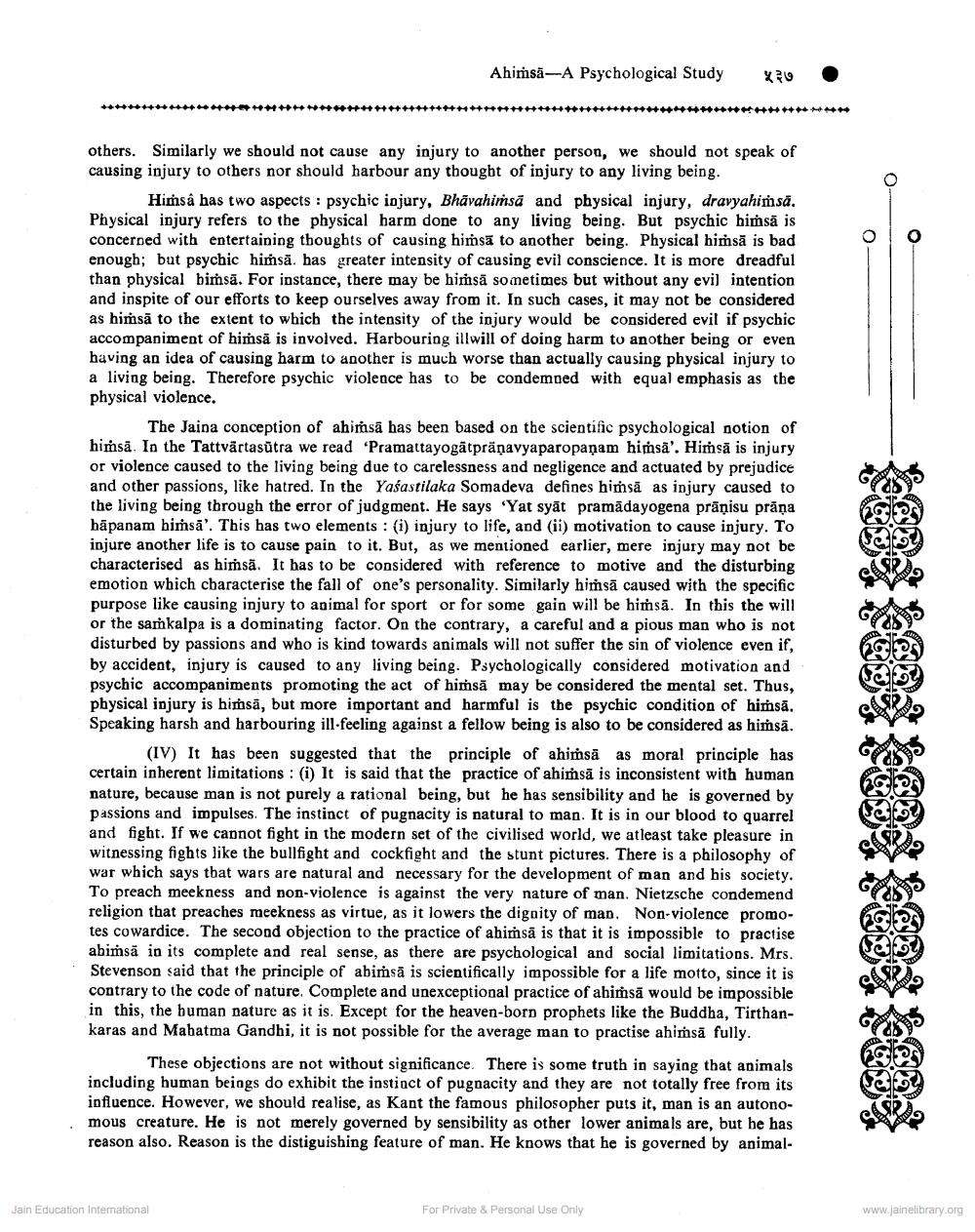________________
Ahimsa-A Psychological Study
9
O
others. Similarly we should not cause any injury to another person, we should not speak of causing injury to others nor should harbour any thought of injury to any living being.
Himsá has two aspects : psychic injury, Bhāvahiṁsā and physical injury, dravyahiṁsā. Physical injury refers to the physical harm done to any living being. But psychic hiṁsā is concerned with entertaining thoughts of causing himsā to another being. Physical himsā is bad enough; but psychic himsă. has greater intensity of causing evil conscience. It is more dreadful than physical biṁsā. For instance, there may be himsā sometimes but without any evil intention and inspite of our efforts to keep ourselves away from it. In such cases, it may not be considered as himsā to the extent to which the intensity of the injury would be considered evil if psychic accompaniment of himsā is involved. Harbouring illwill of doing harm to another being or even having an idea of causing harm to another is much worse than actually causing physical injury to a living being. Therefore psychic violence has to be condemoed with equal emphasis as the physical violence.
The Jaina conception of ahisā has been based on the scientific psychological notion of himsă. In the Tattvārtasūtra we read 'Pramattayogātprāņavyaparopaņam himsa'. Himsā is injury or violence caused to the living being due to carelessness and negligence and actuated by prejudice and other passions, like hatred. In the Yaśastilaka Somadeva defines himsā as injury caused to the living being through the error of judgment. He says "Yat syāt pramādayogena prāņisu prāņa hāpanam biṁsā'. This has two elements : (i) injury to life, and (ii) motivation to cause injury. To injure another life is to cause pain to it. But, as we mentioned earlier, mere injury may not be characterised as himsā. It has to be considered with reference to motive and the disturbing emotion which characterise the fall of one's personality. Similarly himsā caused with the specific purpose like causing injury to animal for sport or for some gain will be hiṁsā. In this the will or the samkalpa is a dominating factor. On the contrary, a careful and a pious man who is not disturbed by passions and who is kind towards animals will not suffer the sin of violence even if, by accident, injury is caused to any living being. Psychologically considered motivation and psychic accompaniments promoting the act of himsā may be considered the mental set. Thus, physical injury is himsa, but more important and harmful is the psychic condition of himsă. Speaking harsh and harbouring ill-feeling against a fellow being is also to be considered as himsā.
(IV) It has been suggested that the principle of ahimsä as moral principle has certain inherent limitations : (i) It is said that the practice of ahimsā is inconsistent with human nature, because man is not purely a rational being, but he has sensibility and he is governed by passions and impulses. The instinct of pugnacity is natural to man. It is in our blood to quarrel and fight. If we cannot fight in the modern set of the civilised world, we atleast take pleasure in witnessing fights like the bullfight and cockfight and the stunt pictures. There is a philosophy of war which says that wars are natural and necessary for the development of man and his society. To preach meekness and non-violence is against the very nature of man. Nietzsche condemend religion that preaches meekness as virtue, as it lowers the dignity of man. Non-violence promotes cowardice. The second objection to the practice of ahimsa is that it is impossible to practise abińsä in its complete and real sense, as there are psychological and social limitations. Mrs. Stevenson said that the principle of abiṁsā is scientifically impossible for a life motto, since it is contrary to the code of nature. Complete and unexceptional practice of ahimsā would be impossible in this, the human nature as it is. Except for the heaven-born prophets like the Buddha, Tirthankaras and Mahatma Gandhi, it is not possible for the average man to practise ahimsā fully.
These objections are not without significance. There is some truth in saying that animals including human beings do exhibit the instinct of pugnacity and they are not totally free from its influence. However, we should realise, as Kant the famous philosopher puts it, man is an autonomous creature. He is not merely governed by sensibility as other lower animals are, but he has reason also. Reason is the distiguishing feature of man. He knows that he is governed by animal
Jain Education International
For Private & Personal Use Only
www.jainelibrary.org




